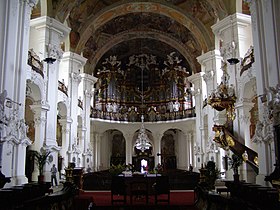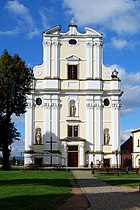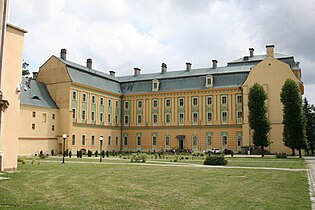Krzeszów Abbey
| Krzeszów Abbey National Heritage of Poland | |
|---|---|
| Native name Polish: Opactwo Cysterskie w Krzeszowie | |
 Churches of the Krzeszów Abbey | |
| Location | Krzeszów, Poland |
| Coordinates | 50°44′04″N 16°04′20″E / 50.73444°N 16.07222°E |
| Area | Europe |
| Architectural style(s) | Baroque |
Historic Monument of Poland | |
| Designated | 2004-04-14 |
| Reference no. | Dz. U. z 2004 r. Nr 102, poz. 1057[1] |
Krzeszów Abbey (
The Abbey, a 1242 Benedictine foundation, from 1289 to 1810 was run by Cistercians, until it was secularized by the Prussian state. Since 1919, it was again run by Benedictines, exiles from Prague. The new location in post-war West Germany was referred to as Grüssau Abbey or Grüssau-Wimpfen. The site of the abbey in Krzeszów, Poland, is known as Krzeszów Abbey. The abbey's Basilica of the Assumption contains a mausoleum of dukes of the Świdnica line of the Polish Piast dynasty.
The name Grüssau Abbey refers to a house of the
The original abbey is now one of Poland's official national
History
Silesia
On 8 May 1242, the monastery at Krzeszów in Lower Silesia in

The Abbey was destroyed during the
After
The territory became again part of Poland according to the 1945
In 1947 Krzeszów Abbey was resettled by Polish Benedictine nuns expelled from Lviv (Lwów) in pre-war eastern Poland annexed by the Soviet Union.
Baden-Württemberg

In 1947 the expelled community under Abbot Albert Schmitt purchased the former Ritterstift (collegiate foundation or canonry) around the Gothic monastery church of Saint Peter in Bad Wimpfen, that had been abandoned since its secularisation in 1803, and became known as Kloster Bad Wimpfen. The last abbot, Laurentius Hoheisel, resigned in 1997. As the membership of the community had declined too far for it to be legally independent, it has been directed since 2001 by the abbot of Neuburg Abbey near Heidelberg.
By the autumn of 2006 no monks remained, the last having moved to Neuburg, although Kloster Bad Wimpfen still remains nominally a Benedictine monastery and is still a member of the
Gallery
-
Basilica of the Assumption
-
Basilica interior
-
Saint Joseph church
-
Saint Joseph church interior
-
Monastery building
-
Abbot House
References
- ^ Rozporządzenie Prezydenta Rzeczypospolitej Polskiej z dnia 14 kwietnia 2004 r. w sprawie uznania za pomnik historii, Dz. U. z 2004 r. Nr 102, poz. 1057
- ^ "Krezeszów Cistercian Abbey". National Heritage Board of Poland. Archived from the original on 17 April 2021. Retrieved 7 May 2018.
- ^ Peter Whitehead (1982). "The treasures at Grüssau"". New Scientist. 94: 226–231.
External links
- Friends of Grüssau Abbey (in German)
- FotoKrzeszow (in Polish)
- View of the abbey from the drone
- Virtual Tour








